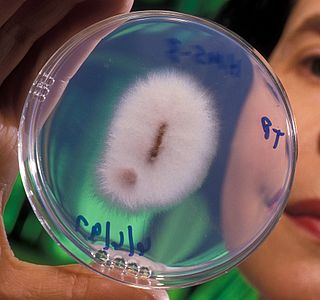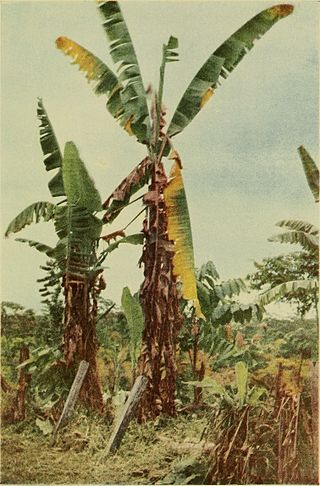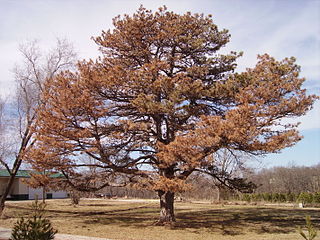
Fusarium oxysporum, an ascomycete fungus, comprises all the species, varieties and forms recognized by Wollenweber and Reinking within an infrageneric grouping called section Elegans. It is part of the family Nectriaceae.

Texas root rot is a disease that is fairly common in Mexico and the southwestern United States resulting in sudden wilt and death of affected plants, usually during the warmer months. It is caused by a soil-borne fungus named Phymatotrichopsis omnivora that attacks the roots of susceptible plants. It was first discovered in 1888 by Pammel and later named by Duggar in 1916.

Fusarium wilt is a common vascular wilt fungal disease, exhibiting symptoms similar to Verticillium wilt. This disease has been investigated extensively since the early years of this century. The pathogen that causes Fusarium wilt is Fusarium oxysporum. The species is further divided into formae speciales based on host plant.

Panama disease is a plant disease that infects banana plants. It is a wilting disease caused by the fungus Fusarium oxysporum f. sp. cubense (Foc). The pathogen is resistant to fungicides and its control is limited to phytosanitary measures.
Aphanomyces euteiches is a water mould, or oomycete, plant pathogen responsible for the disease Aphanomyces root rot. The species Aphanomyces euteiches can infect a variety of legumes. Symptoms of the disease can differ among hosts but generally include reduced root volume and function, leading to stunting and chlorotic foliage. Aphanomyces root rot is an important agricultural disease in the United States, Europe, Australia, New Zealand, and Japan. Management includes using resistant crop varieties and having good soil drainage, as well as testing soil for the pathogen to avoid infected fields.

Phytophthora medicaginis is an oomycete plant pathogen that causes root rot in alfalfa and chickpea. It is a major disease of these plants and is found wherever they are grown. P. medicaginis causes failure of stand establishment because of seedling death. Phytophthora medicaginis is part of a species complex with Phytophthora megasperma.
Helicobasidium longisporum is a Basidiomycete fungal pathogen of plants, which is the cause of violet root rot. The name Violet root rot refers to the dark purple color of the mycelial mats formed on the infected plants, usually at or below the soil line. It can cause total rot and structural failure of roots and subterranean storage organs. Impact of violet root rot on crop loss is often due to stunting of above ground plant growth and decreased vigor, and in extreme cases, whole plant death. It does not directly infect above ground organs. Violet root rot can also damage or cause the death of subterranean storage organs such as potato tubers or carrots.
Verticillium longisporum, also known as Verticillium Wilt, is a fungal plant pathogen that commonly infects canola. V. longisporum can attack other brassica plants as well as woody ornamentals. A main symptom of the infected plant is wilting. In America, V. longsiporum primarily effects eudicot plants. This pathogen can be very devastating and hard to eradicate, responding only to expensive fumigation or fungal resistant plants.
Ceratocystis paradoxa or Black Rot of Pineapple is a plant pathogen that is a fungus, part of the phylum Ascomycota. It is characterized as the teleomorph or sexual reproduction stage of infection. This stage contains ascocarps, or sacs/fruiting bodies, which contain the sexually produced inoculating ascospores. These are the structures which are used primarily to survive long periods of time or overwinter to prepare for the next growing season of its host. Unfortunately, the sexual stage is not often seen in the natural field but instead the anamorph, or asexual stage is more commonly seen. This asexual stage name is Thielaviopsis paradoxa and is the common cause of Black rot or stem-end rot of its hosts.

Albugo is a genus of plant-parasitic oomycetes. Those are not true fungi (Eumycota), although many discussions of this organism still treat it as a fungus. The taxonomy of this genus is incomplete, but several species are plant pathogens. Albugo is one of three genera currently described in the family Albuginaceae, the taxonomy of many species is still in flux.
Aphanomyces cochlioides is a plant pathogen that can affect commodity crops like spinach, Swiss chard, beets and related species. In spinach the pathogen is responsible for the black root "rot" that can damage plants.

Fusarium oxysporum f.sp. ciceris is a fungal plant pathogen that causes fusarium wilt of chickpea.
Pyrenochaeta terrestris is a fungal plant pathogen that infects maize, sweet potatoes, and strawberries. This plant pathogen causes a disease in onion that is commonly called pink root. P. terrestris is also known to infect shallots, garlic, leeks, chives, cantaloupe, carrots, cauliflower, cowpea, cucumbers, eggplants, lima beans, millet, oats, peas, peppers, potatoes, spinach, sugarcane, and tomatoes.

Gibberella fujikuroi is a fungal plant pathogen. It causes bakanae disease in rice seedlings.
Phialophora gregata is a Deuteromycete fungus that is a plant pathogen which causes the disease commonly known as brown stem rot of soybean. P. gregata does not produce survival structures, but has the ability to overwinter as mycelium in decaying soybean residue.

Beet necrotic yellow vein virus (BNYVV) is a plant virus, transmitted by the plasmodiophorid Polymyxa betae. The BNYVV is a member of the genus Benyvirus and is responsible for rhizomania, a disease of sugar beet that causes proliferation of thin rootlets, and leads to a smaller tap root with reduced sugar content. Infected plants are less able to take up water, and wilting can be observed during the warm period of the year. If the infection spreads to the whole plant, vein yellowing, necrosis and yellow spots appear on the leaves, giving the virus its name.

A wilt disease is any number of diseases that affect the vascular system of plants. Attacks by fungi, bacteria, and nematodes can cause rapid killing of plants, large tree branches or even entire trees.

Fusarium oxysporum f. sp. cubensePronunciation (help·info) is a fungal plant pathogen that causes Panama disease of banana, also known as fusarium wilt of banana. The fungi and the related disease are responsible for widespread pressure on banana growing regions, destroying the economic viability of several commercially important banana varieties.

Koa wilt is a relatively new disease to Hawaii, discovered in 1980. Koa wilt is caused by a forma specialis of the fungus Fusarium oxysporum, which is now abundant in Hawaiian soils and infects the native Acacia koa tree, a once-dominant species in the canopy of Hawaiian forests. Fusarium oxysporum f.sp. koae is believed to have been brought into Hawaii on an ornamental acacia plant. Fusarium fungi clog the tree xylem, causing significant wilt and mortality among these beautiful and iconic Hawaiian trees.
Vascular wilt in the perennial shrub lulo or naranjilla is a disease caused by the fungus Fusarium oxysporum f. sp. quitoense.









